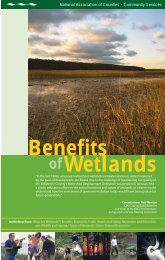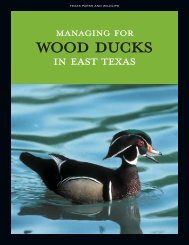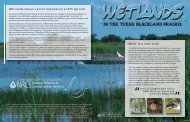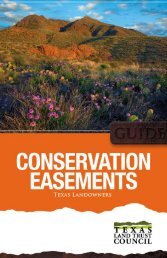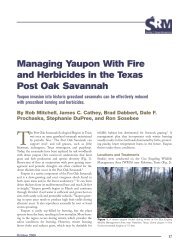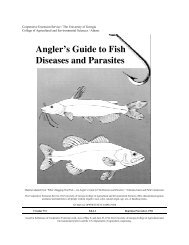Texas Farm Ponds: Stocking, Assessment, and Management ...
Texas Farm Ponds: Stocking, Assessment, and Management ...
Texas Farm Ponds: Stocking, Assessment, and Management ...
You also want an ePaper? Increase the reach of your titles
YUMPU automatically turns print PDFs into web optimized ePapers that Google loves.
Reference section). Algae are very primitive plants<br />
that have no true roots, stems, or leaves <strong>and</strong> do not<br />
produce flowers or seeds. Microscopic algae are<br />
important in the aquatic food chain <strong>and</strong> can be<br />
promoted through fertilization (see fertilization<br />
section). Filamentous <strong>and</strong> macro-algaes (like chara)<br />
often cover large areas <strong>and</strong> need to be controlled to<br />
improve access <strong>and</strong> reduce oxygen depletions. True<br />
floating plants (duckweed, salvinia, water hyacinth,<br />
etc.) increase evaporative water loss <strong>and</strong> can cause<br />
oxygen depletions <strong>and</strong> fish kills if they cover the<br />
entire pond surface. Submerged plants (bushy<br />
pondweed, coontail, milfoil, etc.) are extremely<br />
dense which allow prey species to hide <strong>and</strong> escape<br />
from predator species. The enormous biomass<br />
produced by submerged species often cause oxygen<br />
depletions <strong>and</strong> fish kills. Emergent or shoreline<br />
plants (cattails, lotus, primrose, etc.) reduce access,<br />
increase evaporative water loss, <strong>and</strong> often give prey<br />
species numerous places to hide.<br />
Nuisance aquatic plants need to be controlled<br />
through an Integrated Pest <strong>Management</strong> (IPM)<br />
approach. The IPM approach includes prevention or<br />
1) mechanical, 2) biological, or 3) chemical control.<br />
The best prevention is constructing the pond with<br />
rapid slopes to 2.5-3 feet <strong>and</strong> following a good<br />
fertilization program (see Pond Construction<br />
Planning, Pond Habitat, <strong>and</strong> Fertilization sections).<br />
<strong>Stocking</strong> with grass carp at five to seven per surface<br />
acre before any weed problem appears can also<br />
prevent many submerged weeds from establishing.<br />
It is prudent to start management programs before<br />
the noxious weeds cover large sections (> 20 %) of<br />
the pond.<br />
Mechanical control is daunting <strong>and</strong> not often<br />
practiced. If weeds are mechanically cut they<br />
usually need to be removed from the pond so the<br />
decomposition will not cause oxygen depletions.<br />
Mechanical control is best practiced immediately<br />
when weeds first invade the pond. Physically<br />
removing the first/pioneer cattail or willow stops<br />
their immediate spread <strong>and</strong> saves time <strong>and</strong> expense<br />
on future treatments.<br />
Biological control of submerged weeds is<br />
possible through the use of triploid grass carp.<br />
Permits for triploid grass carp must be obtained from<br />
<strong>Texas</strong> Parks <strong>and</strong> Wildlife Department. <strong>Stocking</strong><br />
rates for grass carp should be based on the species of<br />
weed to be controlled <strong>and</strong> the percent or amount of<br />
the pond coverage (see Reference section). Triploid<br />
grass carp are usually effective at controlling<br />
submerged weeds for five to seven years but usually<br />
live to be 10 to 12 years old. Therefore, they have to<br />
be restocked periodically to maintain control.<br />
Chemical control through the use of EPA<br />
registered herbicides is species specific <strong>and</strong> requires<br />
careful attention to application techniques <strong>and</strong> water<br />
use restrictions (see Reference section). Often when<br />
herbicides are not applied correctly, the massive<br />
amount of weeds killed leads to rapid decomposition<br />
<strong>and</strong> oxygen depletions. Oxygen depletions (see<br />
Aeration section) usually result in fish kills or stress<br />
that leads to parasite <strong>and</strong> disease outbreaks.<br />
Chemical treatment of algae, floating, <strong>and</strong><br />
submerged plants is best done in the early spring<br />
before the plants have time to build up large biomass<br />
<strong>and</strong> while water temperatures are cool <strong>and</strong> dissolved<br />
oxygen levels high. In contrast, chemical treatments<br />
of emergent plants are often best in the fall before<br />
plants go dormant for the winter. Where possible,<br />
most chemical treatments of heavy weed infestations<br />
should be applied in only a portion of the pond <strong>and</strong><br />
not over the entire area. Treating one-quarter to onethird<br />
of the pond at a time, then allowing two weeks<br />
for decomposition before another treatment, will<br />
reduce the chance of an oxygen depletion <strong>and</strong> fish<br />
kill.<br />
The key to aquatic weed control is correct<br />
identification of the noxious weed species <strong>and</strong><br />
selection of the best management option for that<br />
individual plant or alga <strong>and</strong> specific pond<br />
conditions.<br />
Desirable Fish Species<br />
Channel <strong>and</strong> Blue Catfish. These species do<br />
well in most pond environments <strong>and</strong> can be stocked<br />
alone in ponds of any size or as a supplement to bass<br />
<strong>and</strong> forage populations in ponds larger than 1 acre.<br />
Channel catfish (below) are more available for<br />
Joe Tomelleri<br />
stocking, <strong>and</strong> can grow quickly to harvestable size<br />
when fed commercial feed. Pond owners desiring<br />
excessively large catfish can stock blue catfish.<br />
Joe Tomelleri<br />
10




